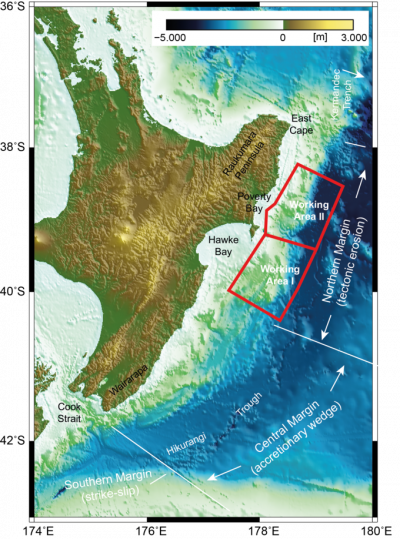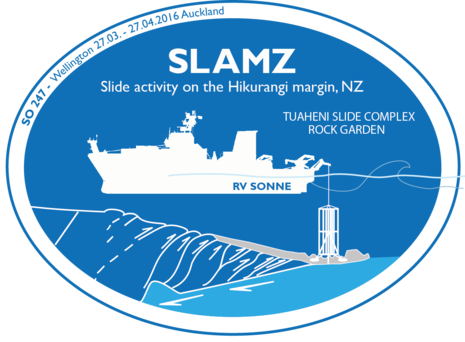Page path:
SO247
RV SONNE SO247 from 03/27/2016 to 04/28/2016 Wellington - Auckland (New Zealand)
SLAMZ - Slide activity on the Hikurangi margin, New Zealand
Submarine landslides are important geologic hazards for seafloor facilities and may generate tsunamis that can cause substantial coastal damage. Numerous studies have hypothesized that gas hydrates play a major role in controlling slope failure initiation and mass-movement processes, but the issue remains controversial. In particular, there is sparse ground-truthing evidence from scientific offshore drilling documenting the influence of bottom water temperature changes during glacial and interglacial cycles, tectonic uplift in subduction zone environments (locally due to seamount subduction), or sediment unroofing on causing the dissociation of gas hydrate, which, in turn, may reduce sediment stability and facilitate submarine landslides.
During SO247 a systematic drilling transects using the sea floor drill rig MeBo, capable of coring up to 200m of subsurface section, will be carried out to investigating the relationship between submarine slope failure processes and gas hydrate dissociation at two target areas characterized by two different morphotectonic settings along the Hikurangi convergent margin: (I) Rock Garden and (II) the Tuaheni slide (see below). These coring operations will be paired with dense heat-flow measurements to characterized the thermal regime and thus hydrate stability; information which are essential to test a number of hypothesis regarding influence of gas hydrate dissociation as potential trigger mechanisms of slides.
During SO247 a systematic drilling transects using the sea floor drill rig MeBo, capable of coring up to 200m of subsurface section, will be carried out to investigating the relationship between submarine slope failure processes and gas hydrate dissociation at two target areas characterized by two different morphotectonic settings along the Hikurangi convergent margin: (I) Rock Garden and (II) the Tuaheni slide (see below). These coring operations will be paired with dense heat-flow measurements to characterized the thermal regime and thus hydrate stability; information which are essential to test a number of hypothesis regarding influence of gas hydrate dissociation as potential trigger mechanisms of slides.


Contact Chief-Scientist:
|
Prof Dr Katrin Huhn |
|
Contact Co-Chief Scientist:
|
Prof Dr Nina Kukowksi |
|
Collaboration partners:
- University Bremen, Germany
- University Jena, Germany
- AWI Bremerhaven, Germany
- NIWA Wellington, NZ
- GNS Wellington, NZ
- University of Auckland, NZ


